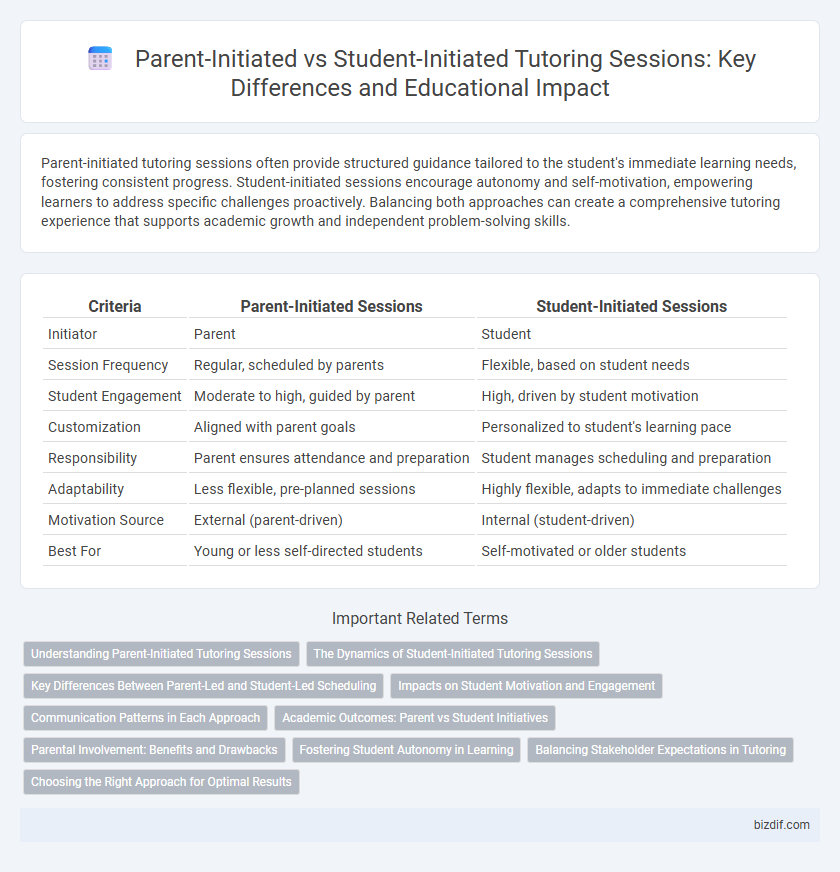Parent-initiated tutoring sessions often provide structured guidance tailored to the student's immediate learning needs, fostering consistent progress. Student-initiated sessions encourage autonomy and self-motivation, empowering learners to address specific challenges proactively. Balancing both approaches can create a comprehensive tutoring experience that supports academic growth and independent problem-solving skills.
Table of Comparison
| Criteria | Parent-Initiated Sessions | Student-Initiated Sessions |
|---|---|---|
| Initiator | Parent | Student |
| Session Frequency | Regular, scheduled by parents | Flexible, based on student needs |
| Student Engagement | Moderate to high, guided by parent | High, driven by student motivation |
| Customization | Aligned with parent goals | Personalized to student's learning pace |
| Responsibility | Parent ensures attendance and preparation | Student manages scheduling and preparation |
| Adaptability | Less flexible, pre-planned sessions | Highly flexible, adapts to immediate challenges |
| Motivation Source | External (parent-driven) | Internal (student-driven) |
| Best For | Young or less self-directed students | Self-motivated or older students |
Understanding Parent-Initiated Tutoring Sessions
Parent-initiated tutoring sessions often reflect a proactive approach to addressing learning gaps, driven by parental observations of their child's academic challenges. These sessions tend to focus on specific skill reinforcement and targeted progress monitoring, ensuring alignment with school curricula and parental expectations. Clear communication between tutors and parents is essential for tailoring instructional strategies and fostering a supportive learning environment.
The Dynamics of Student-Initiated Tutoring Sessions
Student-initiated tutoring sessions foster autonomy and intrinsic motivation by allowing learners to address their specific challenges and curiosities in real-time. These sessions often lead to more personalized learning experiences, as students actively participate in setting the agenda and pace, enhancing engagement and retention. Research indicates that empowering students to initiate tutoring correlates with improved critical thinking skills and long-term academic independence.
Key Differences Between Parent-Led and Student-Led Scheduling
Parent-led tutoring sessions often prioritize structured scheduling based on parental availability and academic concerns, ensuring consistent progress tracking and targeted support. Student-initiated sessions emphasize autonomy and motivation, allowing learners to seek help aligned with their immediate needs and personal learning pace. This dynamic shifts control of timing and topic focus, influencing engagement and responsiveness in the tutoring process.
Impacts on Student Motivation and Engagement
Parent-initiated tutoring sessions often result in lower student motivation and engagement due to perceived external pressure rather than intrinsic interest. In contrast, student-initiated sessions tend to boost autonomy, leading to increased engagement and a more positive attitude towards learning. Research highlights that fostering student-initiated tutoring correlates with higher academic achievement and sustained motivation over time.
Communication Patterns in Each Approach
Parent-initiated tutoring sessions often feature directive communication, with parents setting goals and managing progress updates, which fosters accountability but may limit student autonomy. Student-initiated sessions typically encourage open dialogue, allowing learners to express concerns, ask questions, and take ownership of their learning process. Effective communication in both approaches enhances engagement, but student-driven interactions usually promote deeper critical thinking and self-regulated learning skills.
Academic Outcomes: Parent vs Student Initiatives
Parent-initiated tutoring sessions often lead to more structured academic support, resulting in consistent improvements in student performance and better adherence to learning goals. Student-initiated sessions tend to enhance motivation and autonomy, fostering critical thinking and long-term engagement with the subject matter. Studies indicate that combining both approaches maximizes academic outcomes by balancing structured guidance with self-directed learning.
Parental Involvement: Benefits and Drawbacks
Parental involvement in tutoring sessions often leads to increased accountability and tailored support, enhancing a student's academic performance and motivation. However, excessive parent-initiated sessions can limit the development of student autonomy and self-directed learning skills, potentially reducing long-term educational outcomes. Balancing parent-initiated and student-initiated tutoring encourages independence while maintaining necessary guidance and support.
Fostering Student Autonomy in Learning
Parent-initiated tutoring sessions often provide structure and accountability, supporting consistent learning progress. In contrast, student-initiated sessions encourage self-directed learning, critical thinking, and intrinsic motivation, fostering greater autonomy. Empowering students to schedule and direct their own sessions enhances engagement and cultivates lifelong learning skills.
Balancing Stakeholder Expectations in Tutoring
Balancing stakeholder expectations in tutoring requires recognizing the distinct motivations behind parent-initiated and student-initiated sessions. Parent-initiated sessions often emphasize academic improvement and skill reinforcement, reflecting parental concerns about grades and curriculum alignment. Student-initiated sessions typically focus on interest-driven learning and confidence building, promoting engagement and autonomy essential for long-term academic success.
Choosing the Right Approach for Optimal Results
Parent-initiated tutoring sessions often provide structure and accountability, ensuring consistent progress and addressing specific academic concerns identified by parents. Student-initiated sessions typically foster greater motivation and engagement, empowering learners to focus on areas they find challenging or interesting. Balancing these approaches by assessing the student's needs and learning style leads to optimal tutoring outcomes.
parent-initiated sessions vs student-initiated sessions Infographic

 bizdif.com
bizdif.com